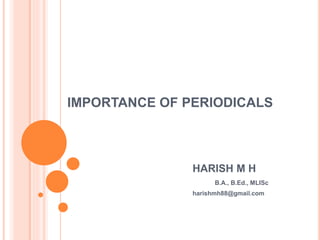
Importance of periodicals
- 1. IMPORTANCE OF PERIODICALS HARISH M H B.A., B.Ed., MLISc harishmh88@gmail.com
- 2. TUMKUR UNIVERSITY TUMKUR GUIDED BY: Dr. B.T SAMPATH KUMAR Chairman & Associate Professor DEPARTMENT OF STUDIES AND RESEARCH OF LIBRARY AND INFORMATION SCIENCE TUMKUR UNIVERSITY TUMKUR
- 3. CONTENT Introduction Definition of Periodicals Information sources Primary sources Periodical Functions of Periodicals The Advantages of Periodicals Conclusion Reference
- 4. INTRODUCTION: Periodicals are publications which are issued at regular intervals, such as journals, magazines, and newspapers. They are also often referred to as serials. Periodicals usually consist of a collection of articles. Every library needs a knowledgeable periodical. It is not always clear that, which titles are essential and which are not. Librarians are in an ideal position to make this assessment but they too have not always agreed. As new members saw the list for the first time they too suggested for additional periodicals. Order all the periodicals you need, including directories and other continuations, from one reliable sources librarians deal with varied and complex issues every day and providing access to the materials needed.
- 5. DEFINITION OF PERIODICALS: A periodical publication containing articles by the various writers. A periodical publication intended for learned or professional readers. Publication whose issues appear at fixed or regular intervals. Periodicals generally are considered to include News paper, which usually have large, in fastened pages and contents with considerable imenedicly and Magazines or Journals, which have smaller pages, are usually fastened or bound, and often more specialized, less time-dependent contents .
- 6. INFORMATION SOURCES Information: The new Webster’s Dictionary of English Language gives the meaning about information is “Intelligence, notice, news or advice communicated by word of warring knowledge derived from the senses or operation of the intellectual faculties”.
- 7. CONT…. Sources: The word information has many concepts. However to arrive or come at plaices definition is very difficult. Sometimes it is difficult to distinguish difference among the concept like facts, data, information, knowledge and understanding . Inspired of this difficulty we can still understand views expressed about it.
- 8. PRIMARY SOURCES: The primary sources are the first published records of original research and development, which has not been filtered through interpretation, condensation or evaluation by a second party. Primary sources are recognized sources, which are rather difficult to use by themselves. The secondary sources help to use these. These are important sources of information. A subject becomes a discipline in its own right when independent primary sources begin to be produced in that area. Primary sources includes periodicals, research monographs, conference proceedings, patents, standards and specification, trade literature, research reports, theses and dissertations, reprints etc.
- 9. PERIODICALS: This includes journals, bulletins, transactions, proceedings and other similar works issued at regulars or stated intervals with a consecutive number. Each part properly contains matter on a variety of topics, generally by several contributions. According to encyclopedia of Library an Information Science “Periodicals refer to a publication with a distinctive title which appears at started or regular intervals generally after once a year without prior decision as to when the last issue shall appear. It contained articles short stories or other writings by several contributors.
- 10. HISTORY OF PERIODICALS: The publication of periodicals are various forms of picture books, songs and calendars was common place throughout the 18th century. However, the term magazine is generally acknowledged to have come into usage with the publication in the 1730s of the Gentleman’s Magazine by Edward Cave. Its aim was to entertain with stories of crime and romance. The early magazines did not confine themselves to leisure interests but were often political or religious in content.
- 11. PERIODICALS ON20TH CENTURY: The early 20th century had seen new styles of magazine, which included edited versions of information. The end of the Second World War saw a further expansion of the periodicals status and comparative who now had business and technical interests as well as expanding leisure pursuits.
- 12. FEATURES OF PERIODICALS: a) Report original research or experimentation, often in specific academic disciplines. b) The targeted audience is the scholarly researcher, faculty, and students. Articles are written by experts in the field, and are signed. Articles often use specialized jargon of the discipline, and assume a familiarity with the subject. Illustrations are few, and support the text, typically in the form of charts, graphs, and maps. Often do not include advertisements. Any advertisements included would be unobtrusive.
- 13. CONT…. Most scholarly journals subject articles to the peer review process prior to publication. Journals that employ the peer review process are also referred to as "refereed journals." Articles usually include footnotes or bibliographies to other sources, using a standardized citation format. Are typically published quarterly.
- 14. THE ADVANTAGES OF USING PERIODICALS a) Because they are published frequently, periodicals are the best sources for current information. b) Current events are usually discussed in periodicals long before they become the subject of a book. Periodicals often contain information on the latest trends, products, research and theories. Periodicals are the best source for ephemeral or very specialized information.
- 15. CONT…. Periodicals exist for every field and every interest, providing access to a variety of hard-to find information. Due to the shorter length of periodical articles, more topics may be covered within one volume of a periodical than in one book.
- 16. CONCLUSION: A periodical is a publication in periodically. It contains Newspapers, magazines and other serial publications. Periodicals are the one of the primary sources which having original information .Periodicals are the important element of library collection, especially in academic, commercial, industrial and research libraries. It is a highly primary media for recording, communicating information.
